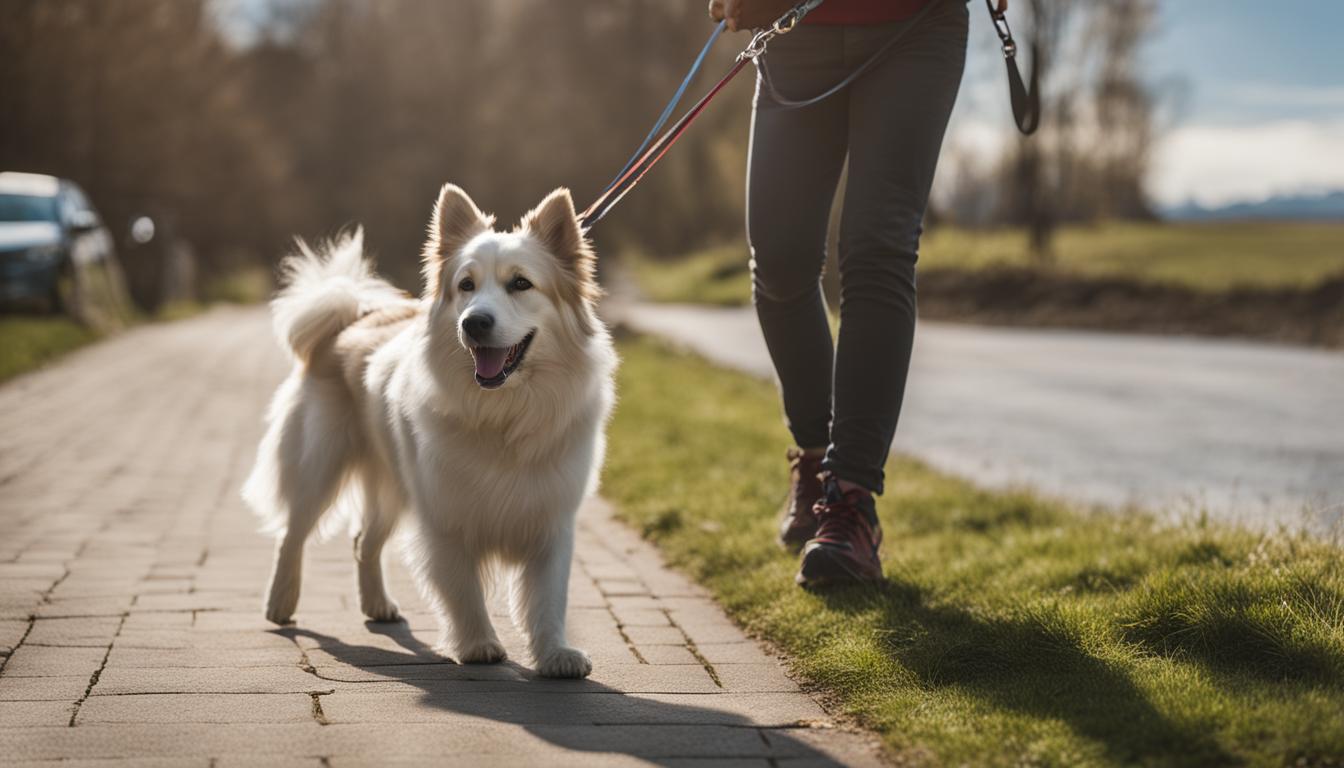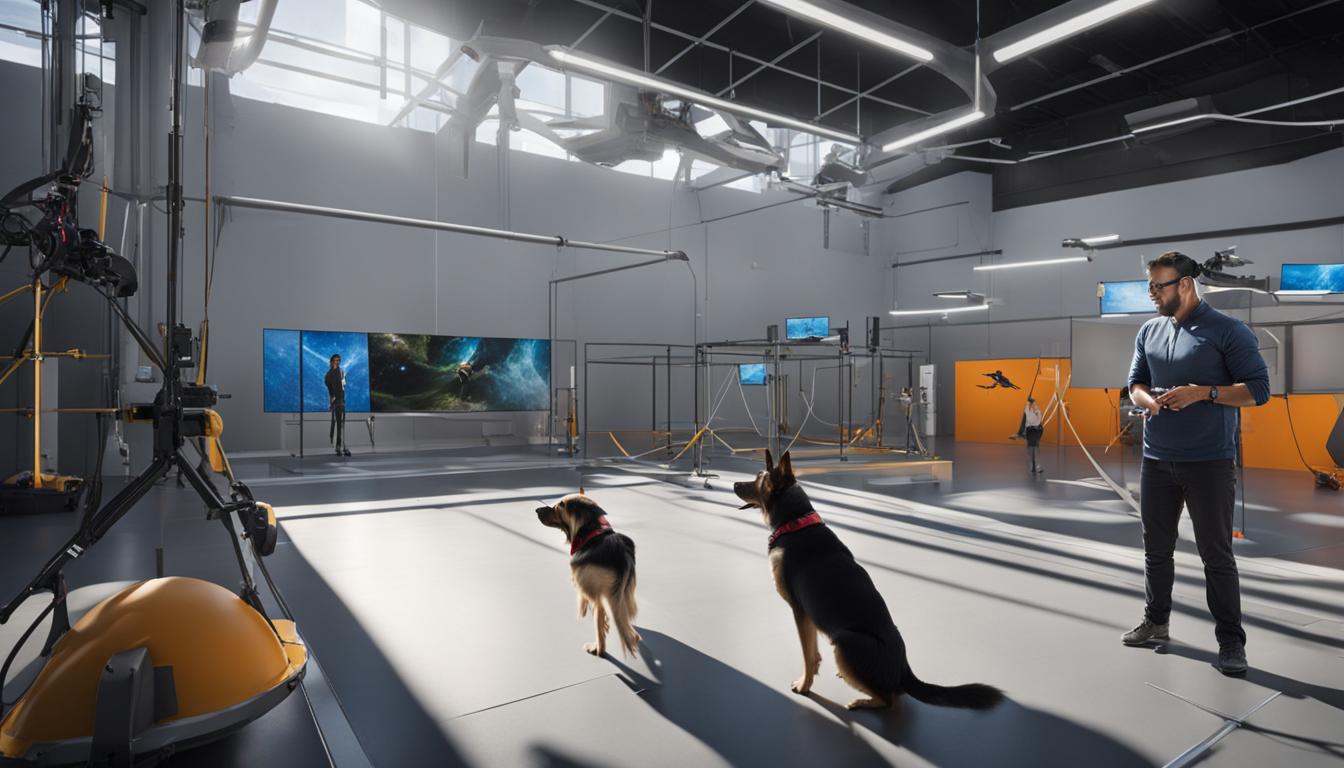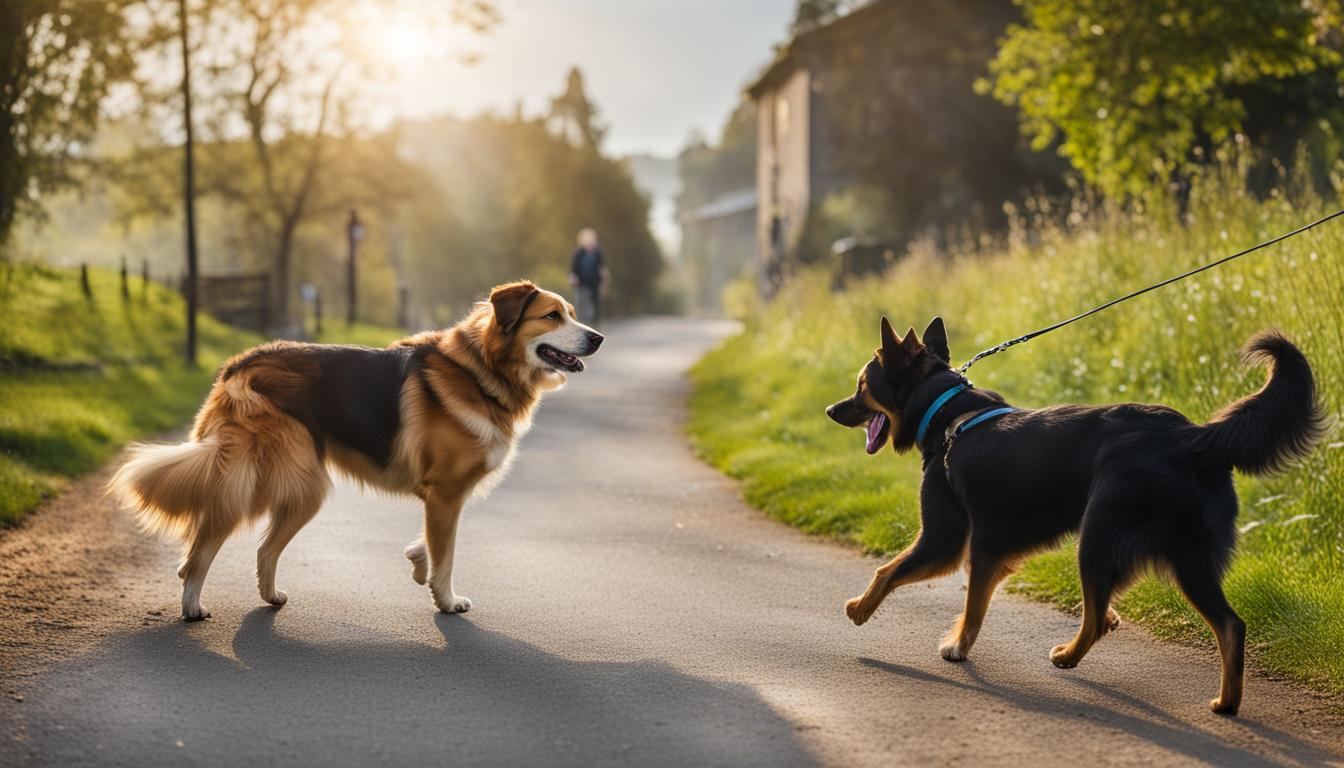Leash training is a crucial skill for dogs to ensure safe and enjoyable walks. With the right techniques, you can teach your furry friend proper leash manners, prevent pulling, and achieve loose-leash walking. By mastering these skills, you’ll be able to have stress-free walks, strengthen your bond with your dog, and create a positive walking experience for both of you.
- Introduce your puppy to the collar and leash in a positive way, using treats and playtime to associate them with fun and rewards.
- Teach loose-leash walking by rewarding your dog’s good behavior and standing still when they pull, gradually reducing treats as they improve.
- Practice leash training in different environments to help your dog generalize their training and handle distractions effectively.
- Address leash aggression with proactive techniques like Behavior Adjustment Training (BAT) and seek professional guidance if needed.
- Develop your own leash handling skills by choosing the right equipment, using reward-based training, and avoiding aversive methods.
Introducing the Puppy to the Collar and Leash
Before you start leash training your puppy, it’s important to introduce them to the collar and leash in a positive way. This will help them associate the collar and leash with fun and rewards.
To do this, let your puppy wear the collar and leash for short periods of time while engaging in play and providing treats. This will help them form positive associations with wearing the collar and leash.
Use a cue, such as a sound or word, that signifies food is coming when introducing the leash. When your puppy turns towards the sound or word, reward them with a treat. This will help them learn to associate the cue with getting a reward.
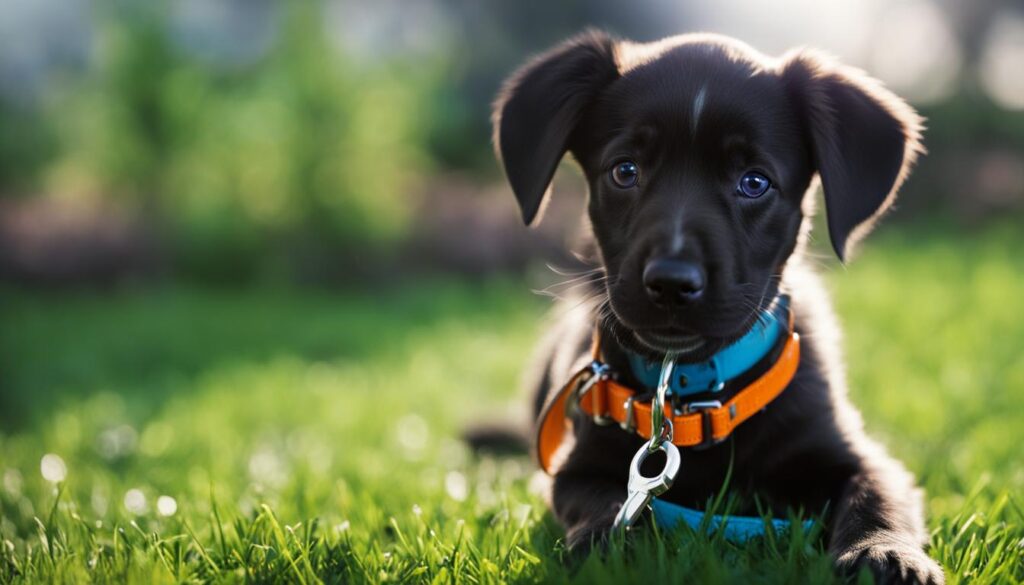
Leash Training Tips
- Make it a positive experience: Use treats and playtime to make your puppy excited about wearing the collar and leash.
- Start gradually: Begin with short periods of time wearing the collar and leash, and gradually increase the duration.
- Keep it fun: Use rewards and positive reinforcement to make leash training enjoyable for your puppy.
- Be patient: Remember that leash training takes time and consistency. Stay calm and persistent throughout the process.
“Introducing your puppy to the collar and leash in a positive way sets the foundation for successful leash training. By associating the collar and leash with rewards and fun, you’re encouraging your puppy to see them as part of an enjoyable experience.” – Kathy Santo, Dog Training Expert
Teaching Loose-Leash Walking
One of the key aspects of leash training is teaching your dog to walk on a loose leash. This means walking without pulling and maintaining good leash manners. Loose-leash walking not only makes walks more enjoyable for both you and your dog but also ensures their safety.
To achieve loose-leash walking, reward-based training techniques are highly effective. The idea is to reward your dog with treats or praise every few paces when they walk without pulling on the leash. This positive reinforcement helps them understand that walking nicely on the leash leads to rewards.
If your dog starts to pull, it’s important to remain patient and consistent. Rather than pulling back on the leash, which can create a tug of war, simply stop walking. This teaches your dog that pulling results in no movement, and they will soon learn that walking resumes only when they come back to your side. Remember to reward your dog when they return to your side and continue walking without pulling.
It’s worth noting that loose-leash walking training can also be used to teach your dog not to chew on the leash. By consistently rewarding their good behavior and redirecting their attention when necessary, you can help them develop proper leash manners.
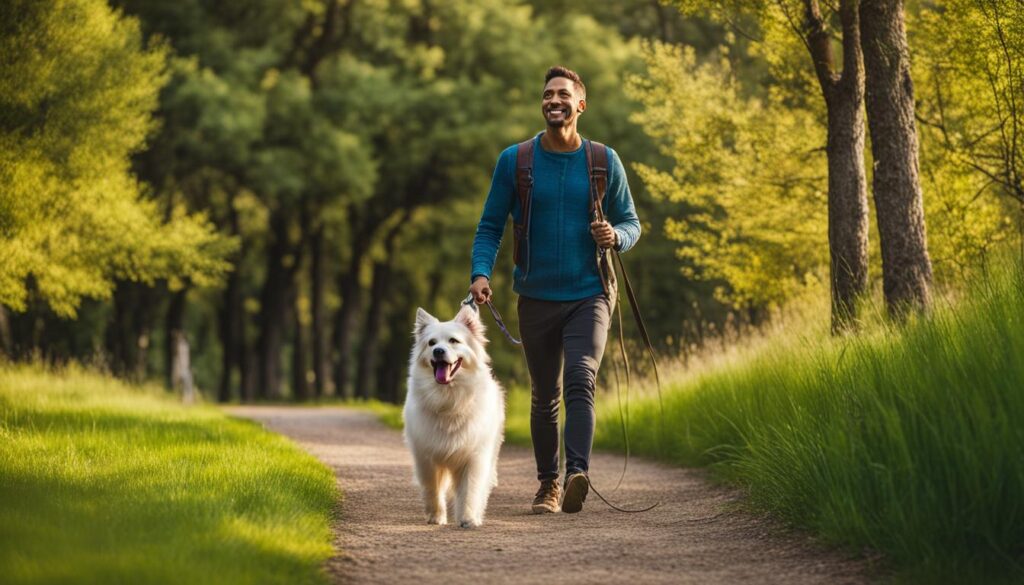
Benefits of Loose-Leash Walking
Training your dog to walk on a loose leash offers a range of benefits. Not only does it make your walks more enjoyable, but it also strengthens the bond between you and your dog. By using reward-based training techniques, you are promoting a positive and trusting relationship with your furry friend. Additionally, loose-leash walking ensures the safety of your dog by preventing them from running off or getting tangled in their leash.
Top Tips for Loose-Leash Walking
- Start training in a quiet and familiar environment before progressing to busier places.
- Use a comfortable and properly fitting collar or harness.
- Have treats readily available as rewards for good behavior.
- Be patient, consistent, and positive throughout the training process.
- Avoid using equipment that causes discomfort or pain, such as choke chains or prong collars.
Common Challenges to Overcome
While teaching loose-leash walking, you may encounter some challenges along the way. Some dogs may have a stronger inclination to pull or become easily distracted. In such cases, it’s important to stay patient and consistent with the training techniques. If needed, seek guidance from a professional dog trainer who specializes in positive reinforcement training methods. They can provide additional support and guidance tailored to your dog’s specific needs.
| Challenge | Solution |
|---|---|
| Pulling on the leash | Stop walking when your dog pulls, and resume walking only when they come back to your side. |
| Becoming easily distracted | Use high-value treats or toys to regain your dog’s attention and reward them for focusing on you. |
| Reverting to old habits | Continue to reinforce good leash manners through consistent training and rewarding their desired behavior. |
Leash Training for Different Environments
Leash training is not limited to just one environment. To ensure that your dog can walk confidently and calmly on a leash in any situation, it is important to practice leash training in various environments. This will help your dog generalize their training and adapt to different walking conditions.
When starting leash training in new places, it is best to begin in a quiet and distraction-free area. This could be your backyard or a calm indoor space. Start by practicing basic leash manners and reinforcing good behavior with treats and praise. Gradually increase the difficulty level by transitioning to more challenging environments, such as local parks or busy streets.
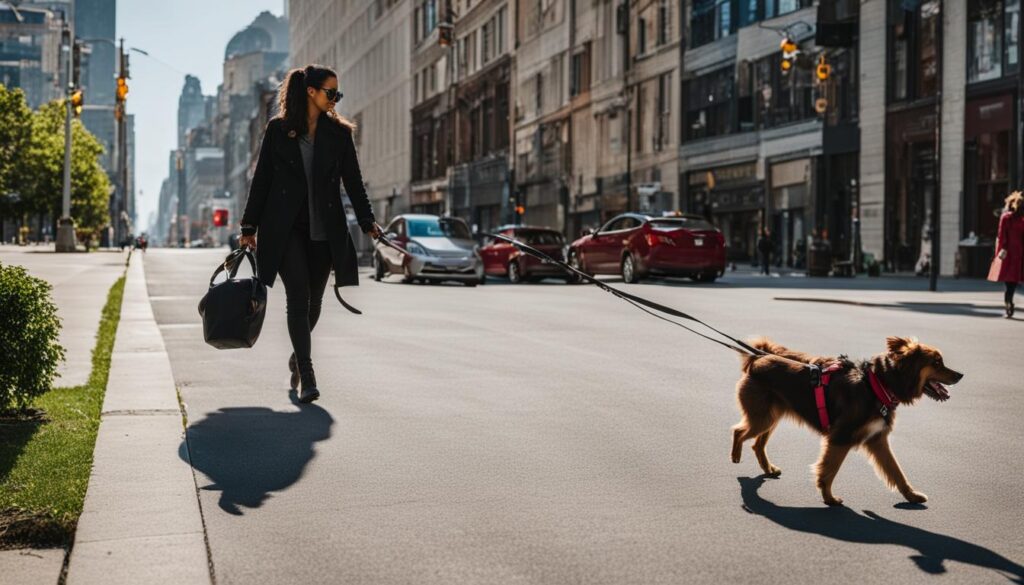
Handling Distractions and New Sights
One of the challenges of leash training in different environments is handling distractions and new sights and sounds. Dogs can become easily excited or distracted by unfamiliar stimuli, such as other dogs, people, or wildlife. To keep your dog focused and prevent pulling or other unwanted behaviors, use a cue sound or word to regain their attention and reinforce good leash manners.
You can also incorporate desensitization exercises into your leash training to help your dog become more comfortable with new sights and sounds. Gradually expose them to different environments, starting with low-intensity distractions and gradually increasing the level of difficulty. Use positive reinforcement, such as treats or playtime, to reward your dog for staying calm and focused on the leash.
Remember, patience and consistency are key when leash training in different environments. With practice and positive reinforcement, your dog will become more confident and well-behaved on walks, no matter where you go.
Table: Leash Training Environments and Progression
| Environment | Training Focus |
|---|---|
| Quiet indoor space | Introduction to leash and basic manners |
| Backyard or enclosed area | Building leash-walking skills |
| Local park or quiet neighborhood | Introducing distractions and new sights |
| Busy streets or crowded areas | Handling high-intensity distractions |
Correcting Leash Aggression in Dogs
Leash aggression, also known as reactivity, can be a challenging issue to address during leash training. Dogs that exhibit leash aggression may bark, growl, or lunge towards other dogs or people when on a leash. This behavior can be caused by fear, frustration, or a lack of socialization. However, with the right techniques and guidance, leash aggression can be corrected.
One effective method for addressing leash aggression is Behavior Adjustment Training (BAT). This proactive leash training technique, developed by dog trainer Grisha Stewart, allows the dog to learn to work through potentially stressful or reactive situations using their natural body language. BAT focuses on creating distance and giving the dog the freedom to make their own choices, which helps them feel more comfortable and reduces their reactivity on the leash. A professional dog trainer experienced in BAT can provide valuable guidance and support throughout the training process.
“Behavior Adjustment Training (BAT) focuses on creating distance and giving the dog the freedom to make their own choices, which helps them feel more comfortable and reduces their reactivity on the leash.”
It is important to note that addressing leash aggression requires patience, consistency, and a positive attitude. Aversive techniques or punitive methods should be avoided, as these can cause anxiety and defensive aggression in dogs. Instead, reward-based training methods, such as using treats and praise, can be used to reinforce calm and non-reactive behavior. Seeking the guidance of a professional dog trainer or animal behaviorist can greatly enhance the effectiveness of leash aggression correction.
| Technique | Key Points |
|---|---|
| Behavior Adjustment Training (BAT) | Focuses on creating distance and allowing the dog to make their own choices |
| Reward-based training | Uses treats and praise to reinforce calm and non-reactive behavior |
| Professional guidance | Consulting with a professional dog trainer or behaviorist can provide valuable support |
Remember, correcting leash aggression takes time and effort. With the right techniques and guidance, you can help your dog overcome their reactivity on the leash and enjoy calm and stress-free walks together.
Key Takeaways:
- Leash aggression, or reactivity, can be addressed through techniques such as Behavior Adjustment Training (BAT).
- Avoid aversive techniques and opt for reward-based training methods to reinforce calm behavior.
- Seek the guidance of a professional dog trainer or behaviorist for effective leash aggression correction.
Leash Handling Skills for Owners
As a responsible dog owner, mastering leash handling skills is crucial for a successful and enjoyable walking experience with your furry friend. Your role in leash training goes beyond simply holding the leash. By understanding the importance of leash length, using comfortable equipment, and being aware of your actions, you can effectively guide your dog’s behavior and ensure their safety.
When it comes to leash length, aim for approximately 2 meters to allow your dog some freedom to explore while still maintaining control. This length strikes the balance between giving your dog enough slack to sniff around and keeping them close enough to prevent any potential accidents or incidents. It’s essential to avoid using retractable leashes as they can lead to entanglement or lack of control in crowded areas.
Equally important is choosing comfortable equipment for your dog. Opt for a well-fitted collar or a front-attach harness that doesn’t cause discomfort or pain. Avoid using choke chains or prong collars, as they can harm your dog physically and negatively impact their overall well-being. By using gentle training aids, you create a positive and comfortable walking experience for your dog.
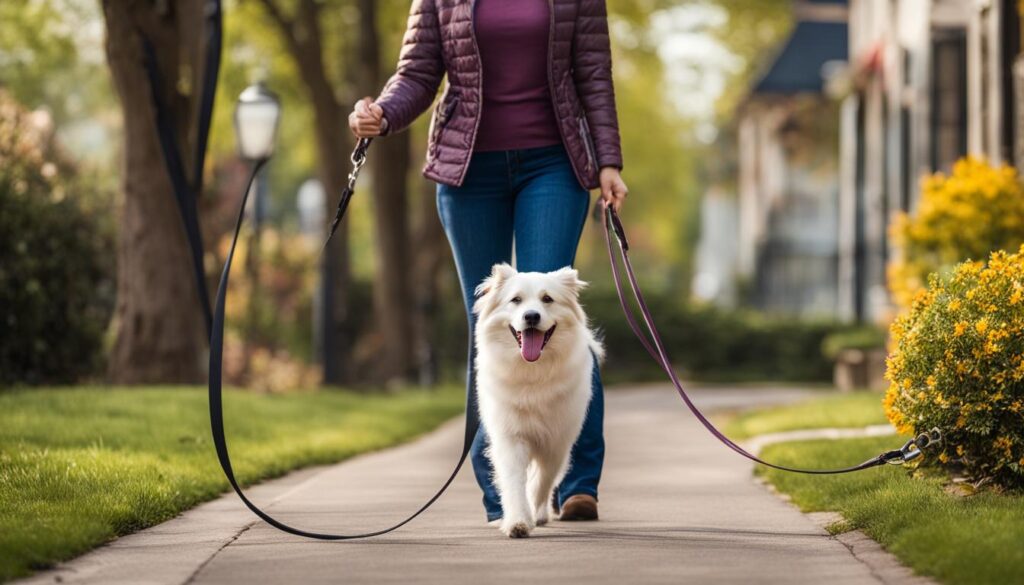
Table: Essential Leash Handling Tips for Dog Owners
| Leash Handling Tip | Description |
|---|---|
| Hold the leash loosely | Avoid tension on the leash, allowing your dog to walk comfortably by your side. |
| Use verbal cues | Teach your dog specific commands like “heel” or “let’s go” to indicate the desired behavior. |
| Be consistent | Establish a routine and stick to it, reinforcing good leash manners consistently. |
| Stay attentive | Be aware of your surroundings and any potential hazards that may require a quick reaction. |
| Show leadership | Lead the walk confidently, signaling to your dog that you are in control. |
By practicing these leash handling skills and maintaining a calm and positive demeanor, you set the foundation for successful leash training. Remember, patience and consistency are key, and always reward your dog for good behavior to reinforce their understanding of the desired leash manners. Together, you and your dog can enjoy many safe and enjoyable walks.
Conclusion
Leash training is the key to enjoyable walks and a strong bond with your furry friend. By implementing effective techniques such as introducing the puppy to the collar and leash, teaching loose-leash walking, and proactive training for leash aggression, you can ensure safe and fulfilling adventures together.
Remember, positive reinforcement is crucial in leash training. Reward your dog with treats and praise when they exhibit good behavior, and be patient and consistent throughout the process. Avoid aversive methods that can cause anxiety or aggression in your pet.
Building a successful leash training routine takes time and effort, but the rewards are worth it. Enjoyable walks not only provide exercise but also strengthen the bond between you and your dog. Don’t forget to prioritize their comfort by using appropriate equipment like a comfortable leash and harness.
Lastly, always prioritize the well-being of your furry companion. Take care of their physical and emotional needs during your walks, and seek professional guidance if you encounter any challenges. With love, patience, and proper training, you can create memorable and satisfying walks for both you and your furry companion.
FAQ
What are some effective techniques for leash training?
Effective leash training techniques include introducing the puppy to the collar and leash, teaching loose-leash walking, and proactive training for leash aggression.
How should I introduce my puppy to the collar and leash?
Introduce the collar and leash by letting the puppy wear them during playtime and rewarding them with treats. This helps them associate the collar and leash with fun and rewards.
How can I teach my dog to walk on a loose leash?
Use reward-based training by rewarding your dog with treats or praise every few paces when they walk on the leash without pulling. If they start to pull, stand still temporarily until they return to your side.
Is it important to practice leash training in different environments?
Yes, it’s important to practice in various environments to help your dog generalize their training. Start in a quiet area and gradually progress to more challenging environments, such as the outdoors.
How can I correct leash aggression in my dog?
Behavior Adjustment Training (BAT) is a proactive leash training technique that allows your dog to work through potential reactive situations using their natural body language. Seek advice from a professional trainer to address leash aggression effectively.
What leash handling skills should owners develop?
Owners should keep a loose leash, use reward-based training techniques, and choose the right equipment, such as a comfortable leash and front-attach harness. Avoid using equipment that causes pain or discomfort.

